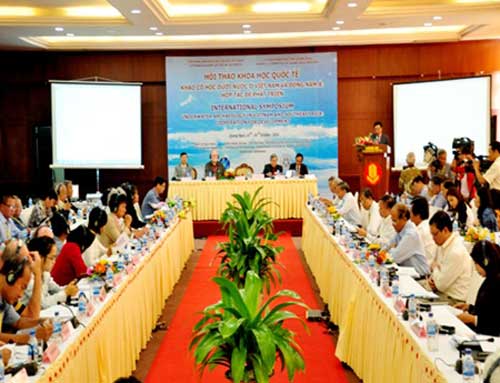VN needs young underwater archaeologists
Viet Nam should train more young people in underwater archaeology research, said Mark Staniforth from La Trobe University of Australia at the International Symposium on Underwater Archaeology in Viet Nam and Southeast Asia, held in Quang Ngai Province yesterday, Oct 15.
 |
|
The International Symposium on Underwater Archaeology in Viet Nam and Southeast Asia held in Quang Ngai Province yesterday. |
"Human resources play a key role in underwater archaeological science; a new science to Viet Nam," Staniforth said. "A proactive boost in studies and research devoted to underwater heritages in Viet Nam is needed. Viet Nam should create job opportunities for young researchers in underwater archaeology studies"
Seafaring activities have occurred along Viet Nam's 3,000km coastline for more than 2,000 years, he said.
"Viet Nam, centrally located in Southeast Asia, was part of the ‘Maritime ceramic route' that saw centuries of trade between China and the west via the East Sea," Staniforth said. "At this stage, very little is known about how many shipwrecks or other maritime and underwater cultural heritage sites might exist in Vietnamese waters as there has been very little underwater archaeology survey work done, but it has been suggested that thousands of sites could be located."
This year's symposium, Viet Nam's first time as host, brought together 170 researchers and archaeologists from 17 countries and territories.
"It's a great chance for international archaeologists to present assessments and recommendations on how best to deal with the historic waters of Binh Chau Commune in Binh Son District. It has been estimated that the area is home to dozens of ancient shipwrecks from between the 8th and 18th century," said Le Quang Thich, vice chairman of the Quang Ngai's People's Committee.
"The province has made drastic efforts to survey and research underwater archaeology to develop the area as a heritage site," Thich said.
According to Thich, two trading vessels dating back some 700 years and other antiquities have already been found in Binh Chau's waters.
"We plan to designate 24sq.km of sea in Binh Chau Commune for detailed investigations and a survey of the ancient shipwrecks. The results will be submitted in an application for national heritage status before aiming for world heritage status."
Nguyen Xuan Thang, chairman of the Viet Nam Academy of Social Sciences, said that Viet Nam has struggled with underwater archaeology studies.
"The symposium is an opportunity for Viet Nam to build global partnerships in the field. It's also a benchmark for the science which is new to Viet Nam," Thang said at the Tuesday opening of the event.
"However, Viet Nam has faced many difficulties - from environmental pollution and climate change to East Sea tensions and an economic downturn," he said.
"Underwater archaeology is a very young science in Viet Nam and only a few research projects have been conducted in the waters of Van Dong district, Cham Island, Thi Nai lagoon and Binh Chau," he said.
Nguyen Giang Hai, the head of Viet Nam's Archaeology Institute, chaired the symposium.
"There is real potential for underwater archaeology research, but poor management and protection of the sites has allowed an alarming amount of exploitation of our ancient heritage for socio-economic development," she said.
Hai said Viet Nam has yet to develop advanced scientific research on underwater archaeology. "The country lacks skilled experts and underwater archaeologists," she stressed.
She warned that local people have stolen precious antiques from within the sunken ships, but the legal framework creates little power to protect underwater heritages.
Hai said 130,000 objects were stolen in the southern Ca Mau Province.
"Most ancient shipwrecks are found by local fishermen and exploited by private companies," he said. "So, it's very difficult to manage and protect the heritage."
Local people often see underwater heritage as profitable, instead of something they want to preserve for its inherent value, Hai said. Underwater heritage is not yet valued for its role in socio-economic development.
The two-day symposium also included field visits to Ly Son Island and the Binh Chau coastal commune to search for old shipwrecks.
An incomplete survey found that the provincial waters could contain eight shipwrecks from between the 10th and 18th centuries.








